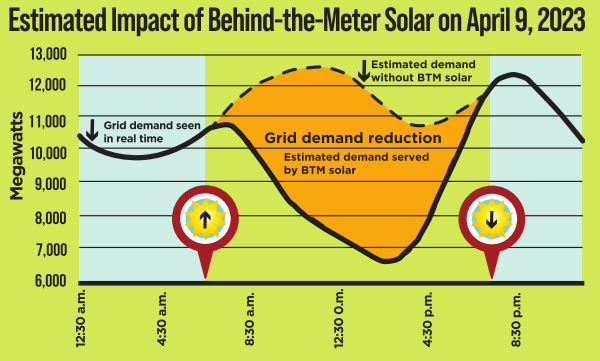
Rooftop solar continues to remake New England’s power grid, replacing electricity from power plants to the point that demand on Easter Sunday afternoon was the lowest on record.
A combination of sunny skies that boosted solar output along with mild temperatures and Easter Sunday, which reduced demand, meant that between 2 and 3 p.m. on Sunday, April 9, an average of just 6,814 megawatts of power was needed as reported by ISO-New England, which oversees the six-state power grid. That is not only the lowest on record but is a full 10 percent less than the previous record of 7,580 MW set on May 1, 2022.
It’s also less than half of the output available at the time, reflecting the financial complications facing traditional power plants that sit idle for hours or days as they are pushed aside by cheaper power from solar and wind.
“The evolution of New England’s power system continues,” said Steven Gould, the ISO’s director of operations, in a prepared statement. “The previous record lasted less than a year, and this one likely won’t last long either.”
Easter Sunday’s lower point occurred as an estimated 4,500 megawatts of electricity, roughly four times the output of the Seabrook Station nuclear power plant, was being produced by rooftop solar. These solar facilities are “behind the meter” so they don’t get directly measured by ISO-NE; their output shows up as a reduction in demand. Large-scale, industrial solar plants that are measured by ISO-NE contributed roughly another 500 MW of electricity.
New England’s solar output tends to peak in spring from a combination of sunny days and the cooler temperatures that electronic systems like. Decreased demand on Easter Sunday, when many businesses were closed, contributed to the record. In midsummer when it’s cloudy and still, bulk demand can exceed 20,000 MW.
The increase of rooftop solar during the day has changed the traditional pattern of power production. Previously, the power needs of New England rose in the morning, stayed roughly level during the day, increased a bit when people got home after work and then fell, reaching a low point after midnight.
On sunny days, however, demand falls sharply during the day as it gets replaced by rooftop solar, creating what is known as a “duck curve.” At the extreme, called a “duck curve day,” demand from the bulk power system is at its lowest in the afternoon rather than overnight. Such days are increasingly common in spring and fall.
This article is being shared by partners in The Granite State News Collaborative. For more information, visit collaborativenh.org.